The Titanic: A Project Management Failure Case Study Report
VerifiedAdded on 2021/06/05
|7
|1181
|412
Report
AI Summary
This report provides a detailed analysis of the Titanic disaster from a project management perspective. It examines the factors contributing to the project's failure, including stakeholder conflicts, scope creep, flawed communication, and inadequate testing. The report delves into the project's background, highlighting issues with the design and construction processes, as well as the lack of a proper testing phase. It explores how varying priorities among stakeholders led to scope creep, and how lessons learned from a previous incident (the Olympic collision) were misapplied. The analysis also covers issues like the lack of appropriate tools (e.g., binoculars in the crow's nest), poor communication between the crew, and the absence of a central control mechanism. The report concludes by emphasizing the lack of strong leadership and systemic approach in managing the project, which ultimately contributed to the tragedy. The report references sources such as Harrison and Lock (2017), Kendrick (2015), Kerzner and Kerzner (2017), Kerzner (2018), and Procter and Kozak-Holland (2015) to support its findings.
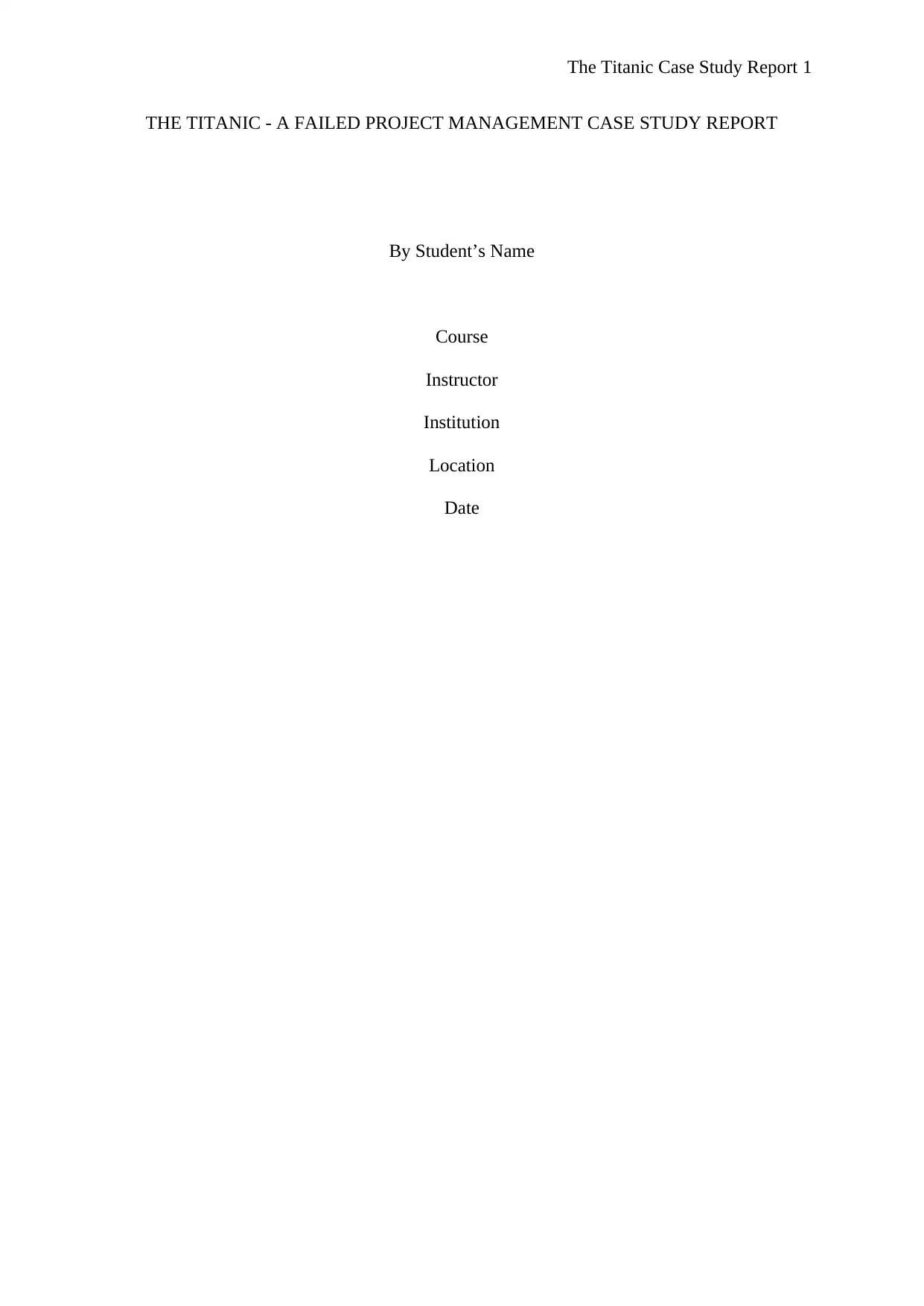
The Titanic Case Study Report 1
THE TITANIC - A FAILED PROJECT MANAGEMENT CASE STUDY REPORT
By Student’s Name
Course
Instructor
Institution
Location
Date
THE TITANIC - A FAILED PROJECT MANAGEMENT CASE STUDY REPORT
By Student’s Name
Course
Instructor
Institution
Location
Date
Paraphrase This Document
Need a fresh take? Get an instant paraphrase of this document with our AI Paraphraser
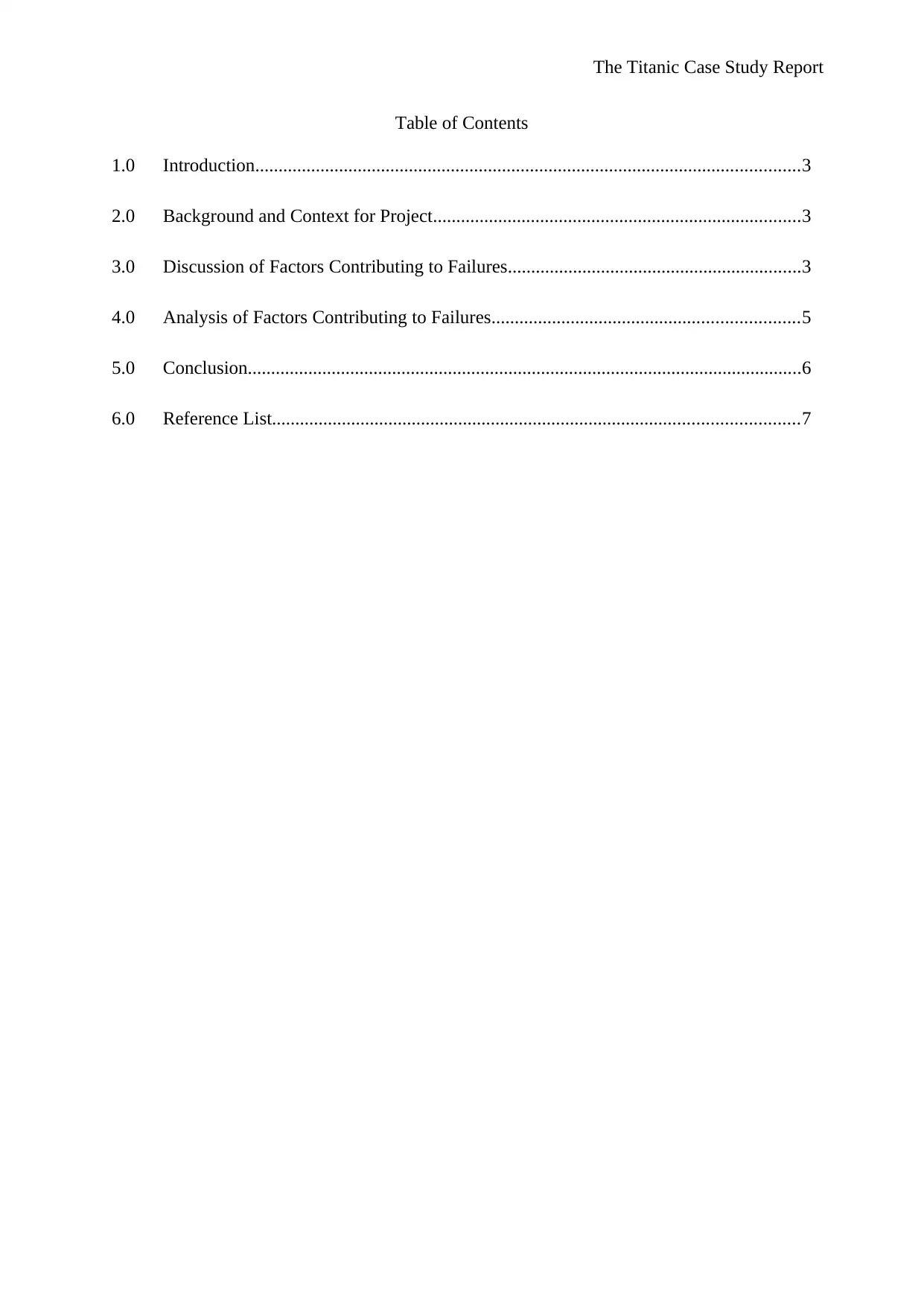
The Titanic Case Study Report
Table of Contents
1.0 Introduction.....................................................................................................................3
2.0 Background and Context for Project...............................................................................3
3.0 Discussion of Factors Contributing to Failures...............................................................3
4.0 Analysis of Factors Contributing to Failures..................................................................5
5.0 Conclusion.......................................................................................................................6
6.0 Reference List.................................................................................................................7
Table of Contents
1.0 Introduction.....................................................................................................................3
2.0 Background and Context for Project...............................................................................3
3.0 Discussion of Factors Contributing to Failures...............................................................3
4.0 Analysis of Factors Contributing to Failures..................................................................5
5.0 Conclusion.......................................................................................................................6
6.0 Reference List.................................................................................................................7
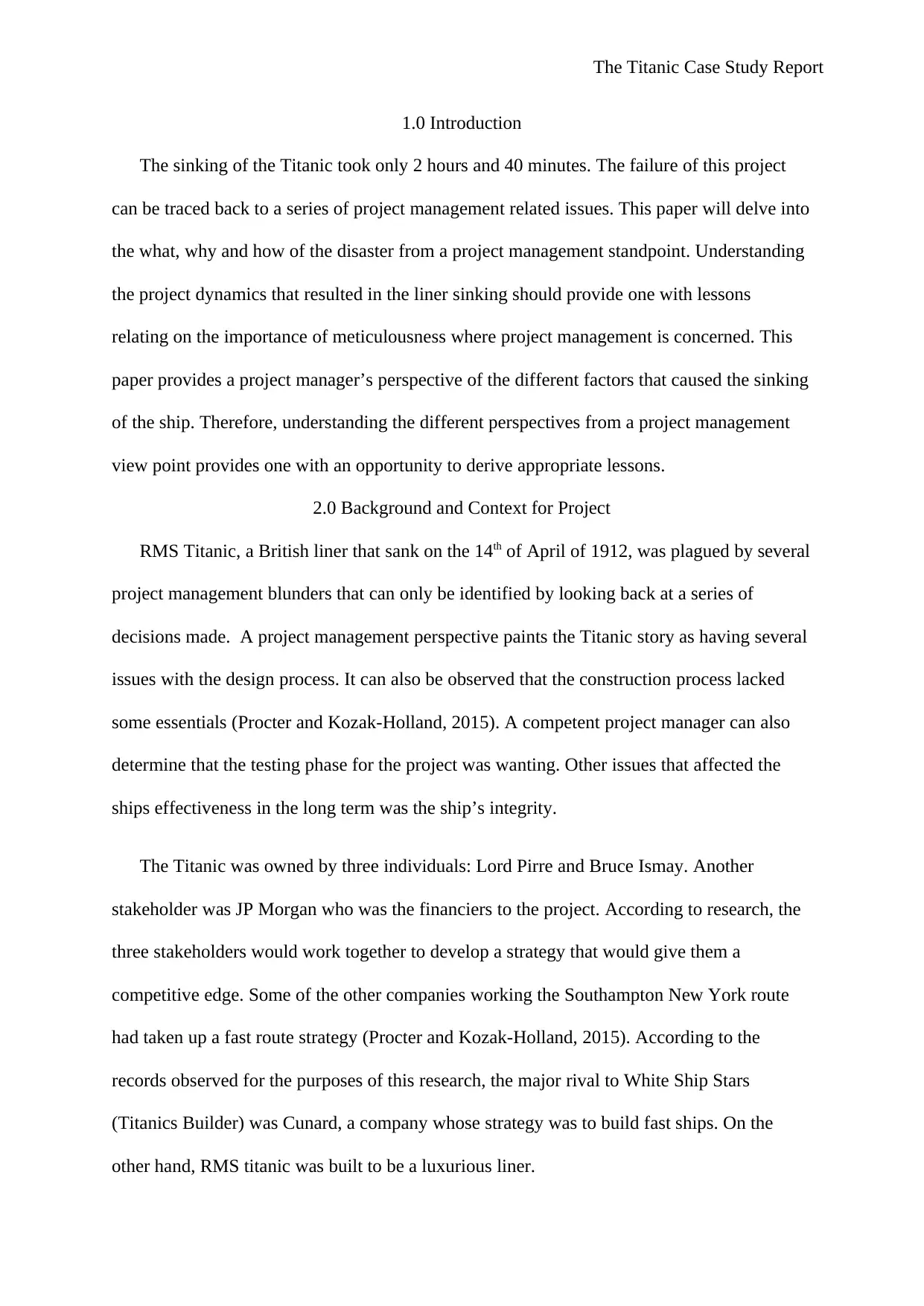
The Titanic Case Study Report
1.0 Introduction
The sinking of the Titanic took only 2 hours and 40 minutes. The failure of this project
can be traced back to a series of project management related issues. This paper will delve into
the what, why and how of the disaster from a project management standpoint. Understanding
the project dynamics that resulted in the liner sinking should provide one with lessons
relating on the importance of meticulousness where project management is concerned. This
paper provides a project manager’s perspective of the different factors that caused the sinking
of the ship. Therefore, understanding the different perspectives from a project management
view point provides one with an opportunity to derive appropriate lessons.
2.0 Background and Context for Project
RMS Titanic, a British liner that sank on the 14th of April of 1912, was plagued by several
project management blunders that can only be identified by looking back at a series of
decisions made. A project management perspective paints the Titanic story as having several
issues with the design process. It can also be observed that the construction process lacked
some essentials (Procter and Kozak-Holland, 2015). A competent project manager can also
determine that the testing phase for the project was wanting. Other issues that affected the
ships effectiveness in the long term was the ship’s integrity.
The Titanic was owned by three individuals: Lord Pirre and Bruce Ismay. Another
stakeholder was JP Morgan who was the financiers to the project. According to research, the
three stakeholders would work together to develop a strategy that would give them a
competitive edge. Some of the other companies working the Southampton New York route
had taken up a fast route strategy (Procter and Kozak-Holland, 2015). According to the
records observed for the purposes of this research, the major rival to White Ship Stars
(Titanics Builder) was Cunard, a company whose strategy was to build fast ships. On the
other hand, RMS titanic was built to be a luxurious liner.
1.0 Introduction
The sinking of the Titanic took only 2 hours and 40 minutes. The failure of this project
can be traced back to a series of project management related issues. This paper will delve into
the what, why and how of the disaster from a project management standpoint. Understanding
the project dynamics that resulted in the liner sinking should provide one with lessons
relating on the importance of meticulousness where project management is concerned. This
paper provides a project manager’s perspective of the different factors that caused the sinking
of the ship. Therefore, understanding the different perspectives from a project management
view point provides one with an opportunity to derive appropriate lessons.
2.0 Background and Context for Project
RMS Titanic, a British liner that sank on the 14th of April of 1912, was plagued by several
project management blunders that can only be identified by looking back at a series of
decisions made. A project management perspective paints the Titanic story as having several
issues with the design process. It can also be observed that the construction process lacked
some essentials (Procter and Kozak-Holland, 2015). A competent project manager can also
determine that the testing phase for the project was wanting. Other issues that affected the
ships effectiveness in the long term was the ship’s integrity.
The Titanic was owned by three individuals: Lord Pirre and Bruce Ismay. Another
stakeholder was JP Morgan who was the financiers to the project. According to research, the
three stakeholders would work together to develop a strategy that would give them a
competitive edge. Some of the other companies working the Southampton New York route
had taken up a fast route strategy (Procter and Kozak-Holland, 2015). According to the
records observed for the purposes of this research, the major rival to White Ship Stars
(Titanics Builder) was Cunard, a company whose strategy was to build fast ships. On the
other hand, RMS titanic was built to be a luxurious liner.
⊘ This is a preview!⊘
Do you want full access?
Subscribe today to unlock all pages.

Trusted by 1+ million students worldwide
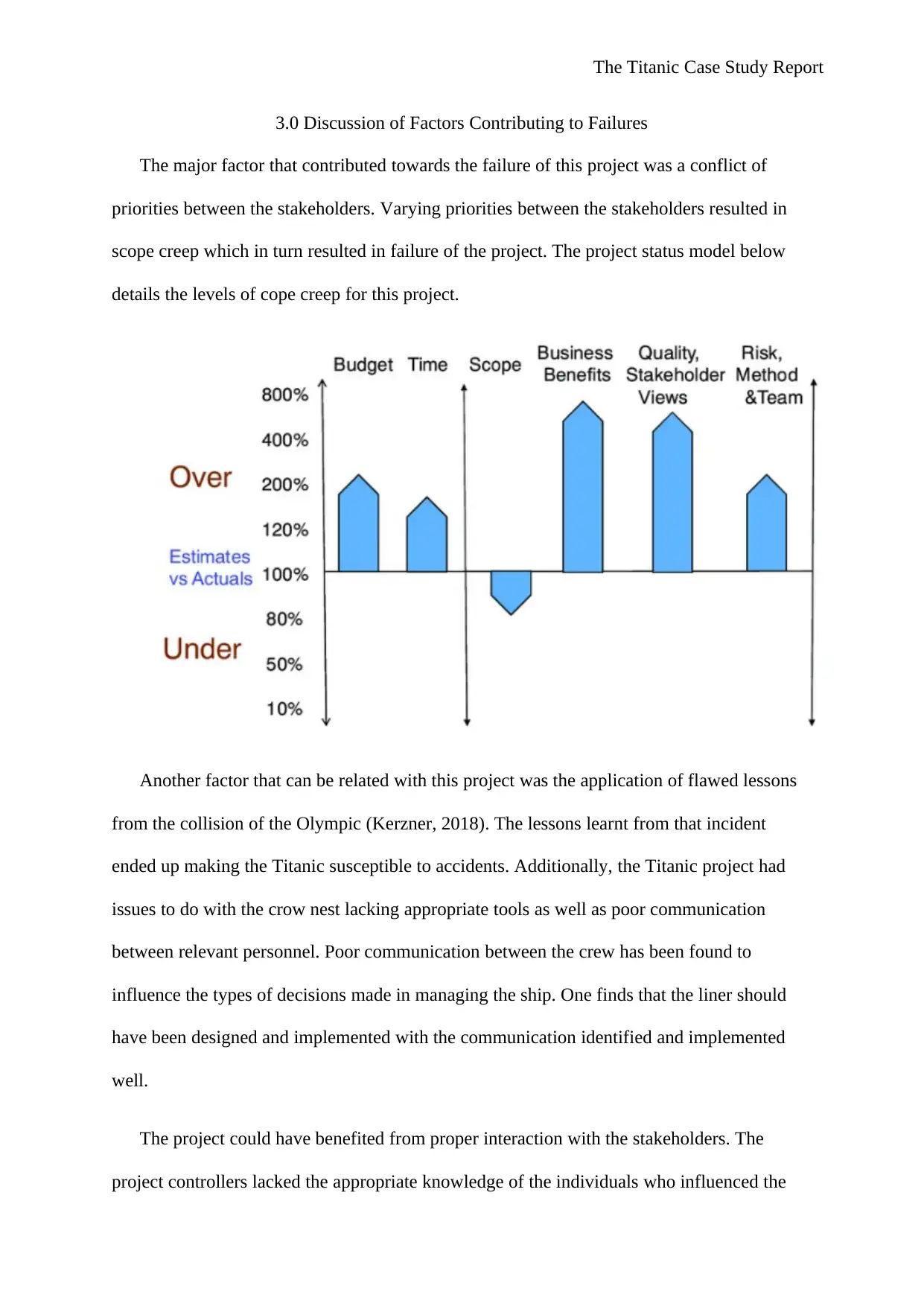
The Titanic Case Study Report
3.0 Discussion of Factors Contributing to Failures
The major factor that contributed towards the failure of this project was a conflict of
priorities between the stakeholders. Varying priorities between the stakeholders resulted in
scope creep which in turn resulted in failure of the project. The project status model below
details the levels of cope creep for this project.
Another factor that can be related with this project was the application of flawed lessons
from the collision of the Olympic (Kerzner, 2018). The lessons learnt from that incident
ended up making the Titanic susceptible to accidents. Additionally, the Titanic project had
issues to do with the crow nest lacking appropriate tools as well as poor communication
between relevant personnel. Poor communication between the crew has been found to
influence the types of decisions made in managing the ship. One finds that the liner should
have been designed and implemented with the communication identified and implemented
well.
The project could have benefited from proper interaction with the stakeholders. The
project controllers lacked the appropriate knowledge of the individuals who influenced the
3.0 Discussion of Factors Contributing to Failures
The major factor that contributed towards the failure of this project was a conflict of
priorities between the stakeholders. Varying priorities between the stakeholders resulted in
scope creep which in turn resulted in failure of the project. The project status model below
details the levels of cope creep for this project.
Another factor that can be related with this project was the application of flawed lessons
from the collision of the Olympic (Kerzner, 2018). The lessons learnt from that incident
ended up making the Titanic susceptible to accidents. Additionally, the Titanic project had
issues to do with the crow nest lacking appropriate tools as well as poor communication
between relevant personnel. Poor communication between the crew has been found to
influence the types of decisions made in managing the ship. One finds that the liner should
have been designed and implemented with the communication identified and implemented
well.
The project could have benefited from proper interaction with the stakeholders. The
project controllers lacked the appropriate knowledge of the individuals who influenced the
Paraphrase This Document
Need a fresh take? Get an instant paraphrase of this document with our AI Paraphraser
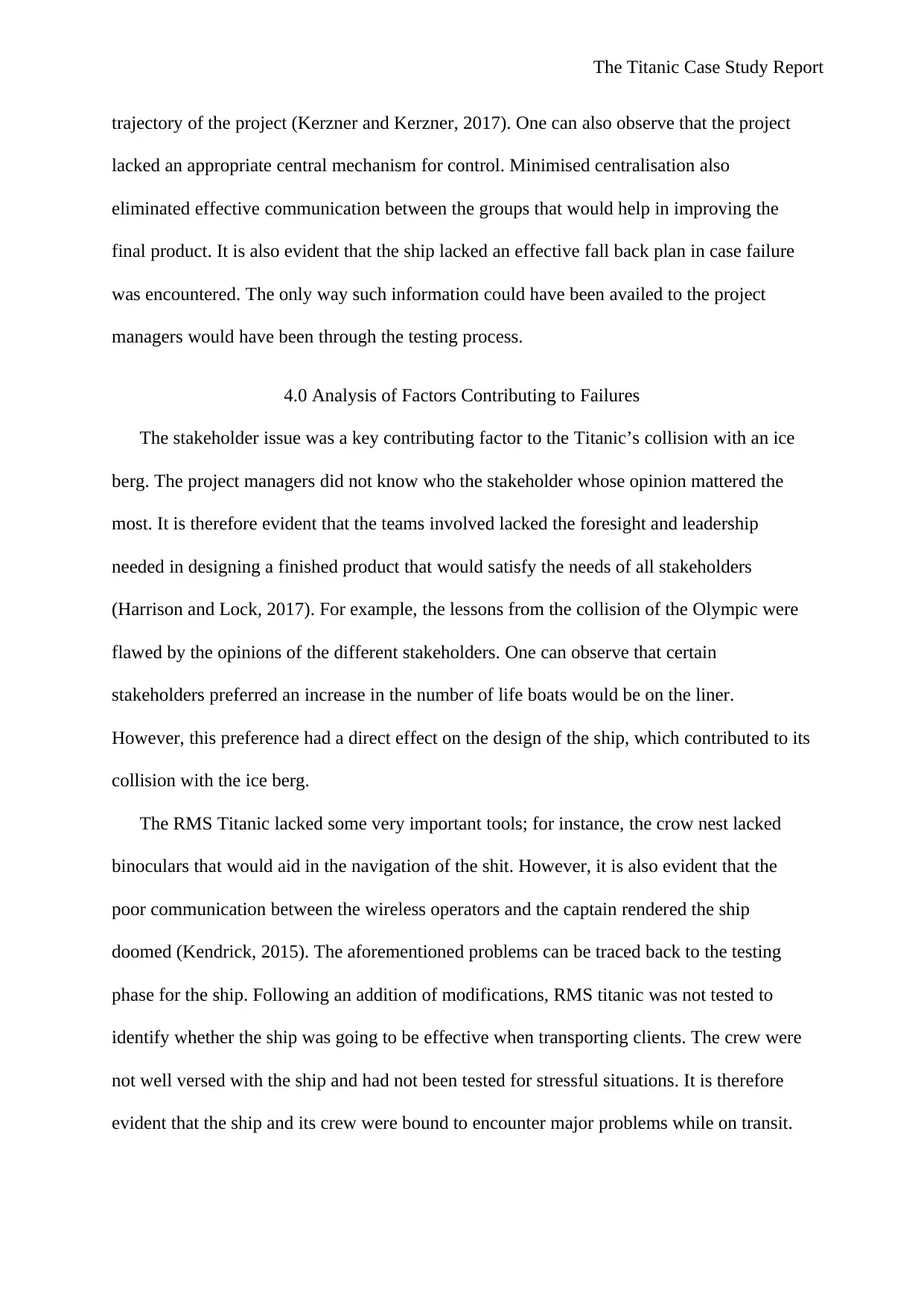
The Titanic Case Study Report
trajectory of the project (Kerzner and Kerzner, 2017). One can also observe that the project
lacked an appropriate central mechanism for control. Minimised centralisation also
eliminated effective communication between the groups that would help in improving the
final product. It is also evident that the ship lacked an effective fall back plan in case failure
was encountered. The only way such information could have been availed to the project
managers would have been through the testing process.
4.0 Analysis of Factors Contributing to Failures
The stakeholder issue was a key contributing factor to the Titanic’s collision with an ice
berg. The project managers did not know who the stakeholder whose opinion mattered the
most. It is therefore evident that the teams involved lacked the foresight and leadership
needed in designing a finished product that would satisfy the needs of all stakeholders
(Harrison and Lock, 2017). For example, the lessons from the collision of the Olympic were
flawed by the opinions of the different stakeholders. One can observe that certain
stakeholders preferred an increase in the number of life boats would be on the liner.
However, this preference had a direct effect on the design of the ship, which contributed to its
collision with the ice berg.
The RMS Titanic lacked some very important tools; for instance, the crow nest lacked
binoculars that would aid in the navigation of the shit. However, it is also evident that the
poor communication between the wireless operators and the captain rendered the ship
doomed (Kendrick, 2015). The aforementioned problems can be traced back to the testing
phase for the ship. Following an addition of modifications, RMS titanic was not tested to
identify whether the ship was going to be effective when transporting clients. The crew were
not well versed with the ship and had not been tested for stressful situations. It is therefore
evident that the ship and its crew were bound to encounter major problems while on transit.
trajectory of the project (Kerzner and Kerzner, 2017). One can also observe that the project
lacked an appropriate central mechanism for control. Minimised centralisation also
eliminated effective communication between the groups that would help in improving the
final product. It is also evident that the ship lacked an effective fall back plan in case failure
was encountered. The only way such information could have been availed to the project
managers would have been through the testing process.
4.0 Analysis of Factors Contributing to Failures
The stakeholder issue was a key contributing factor to the Titanic’s collision with an ice
berg. The project managers did not know who the stakeholder whose opinion mattered the
most. It is therefore evident that the teams involved lacked the foresight and leadership
needed in designing a finished product that would satisfy the needs of all stakeholders
(Harrison and Lock, 2017). For example, the lessons from the collision of the Olympic were
flawed by the opinions of the different stakeholders. One can observe that certain
stakeholders preferred an increase in the number of life boats would be on the liner.
However, this preference had a direct effect on the design of the ship, which contributed to its
collision with the ice berg.
The RMS Titanic lacked some very important tools; for instance, the crow nest lacked
binoculars that would aid in the navigation of the shit. However, it is also evident that the
poor communication between the wireless operators and the captain rendered the ship
doomed (Kendrick, 2015). The aforementioned problems can be traced back to the testing
phase for the ship. Following an addition of modifications, RMS titanic was not tested to
identify whether the ship was going to be effective when transporting clients. The crew were
not well versed with the ship and had not been tested for stressful situations. It is therefore
evident that the ship and its crew were bound to encounter major problems while on transit.
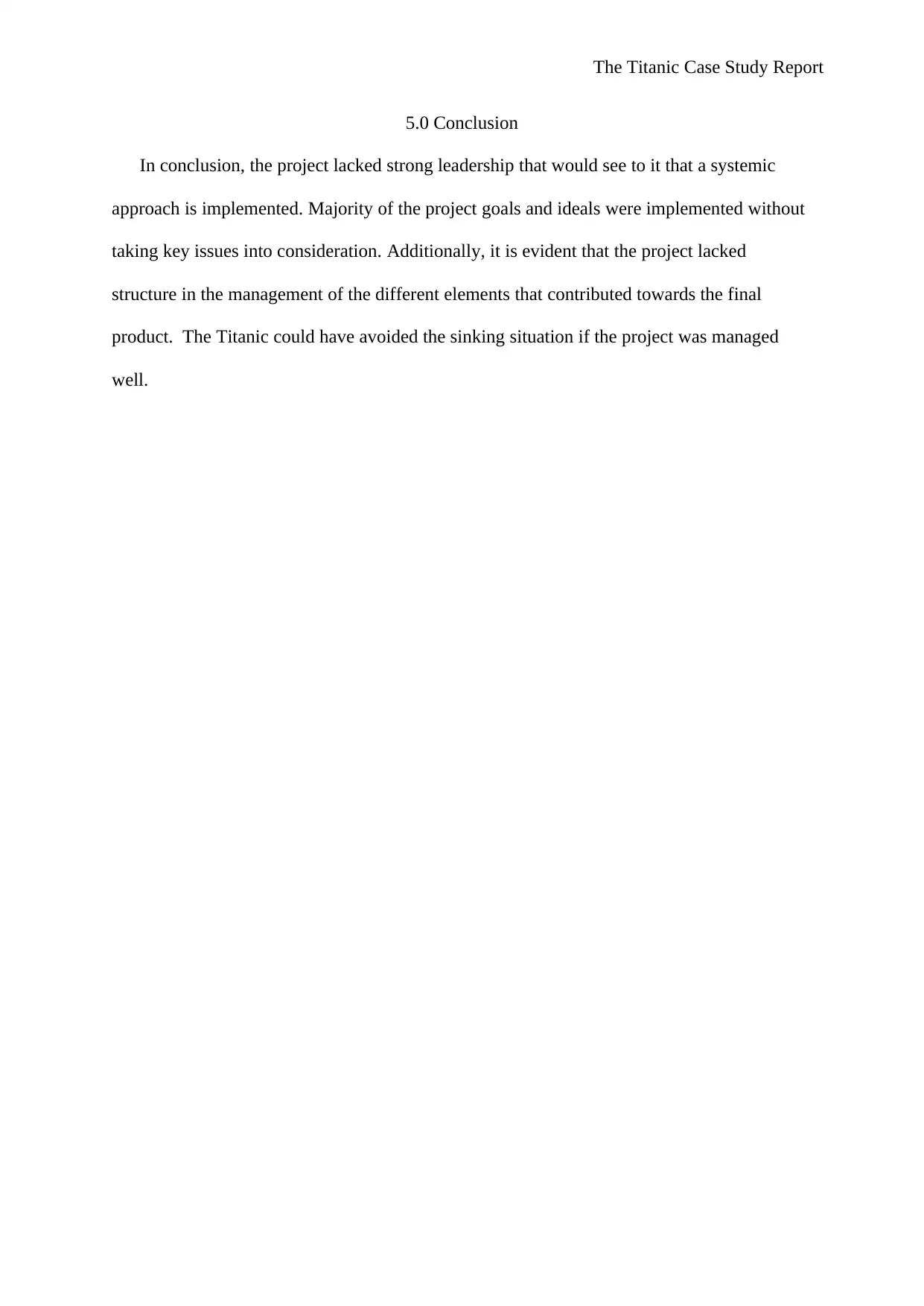
The Titanic Case Study Report
5.0 Conclusion
In conclusion, the project lacked strong leadership that would see to it that a systemic
approach is implemented. Majority of the project goals and ideals were implemented without
taking key issues into consideration. Additionally, it is evident that the project lacked
structure in the management of the different elements that contributed towards the final
product. The Titanic could have avoided the sinking situation if the project was managed
well.
5.0 Conclusion
In conclusion, the project lacked strong leadership that would see to it that a systemic
approach is implemented. Majority of the project goals and ideals were implemented without
taking key issues into consideration. Additionally, it is evident that the project lacked
structure in the management of the different elements that contributed towards the final
product. The Titanic could have avoided the sinking situation if the project was managed
well.
⊘ This is a preview!⊘
Do you want full access?
Subscribe today to unlock all pages.

Trusted by 1+ million students worldwide
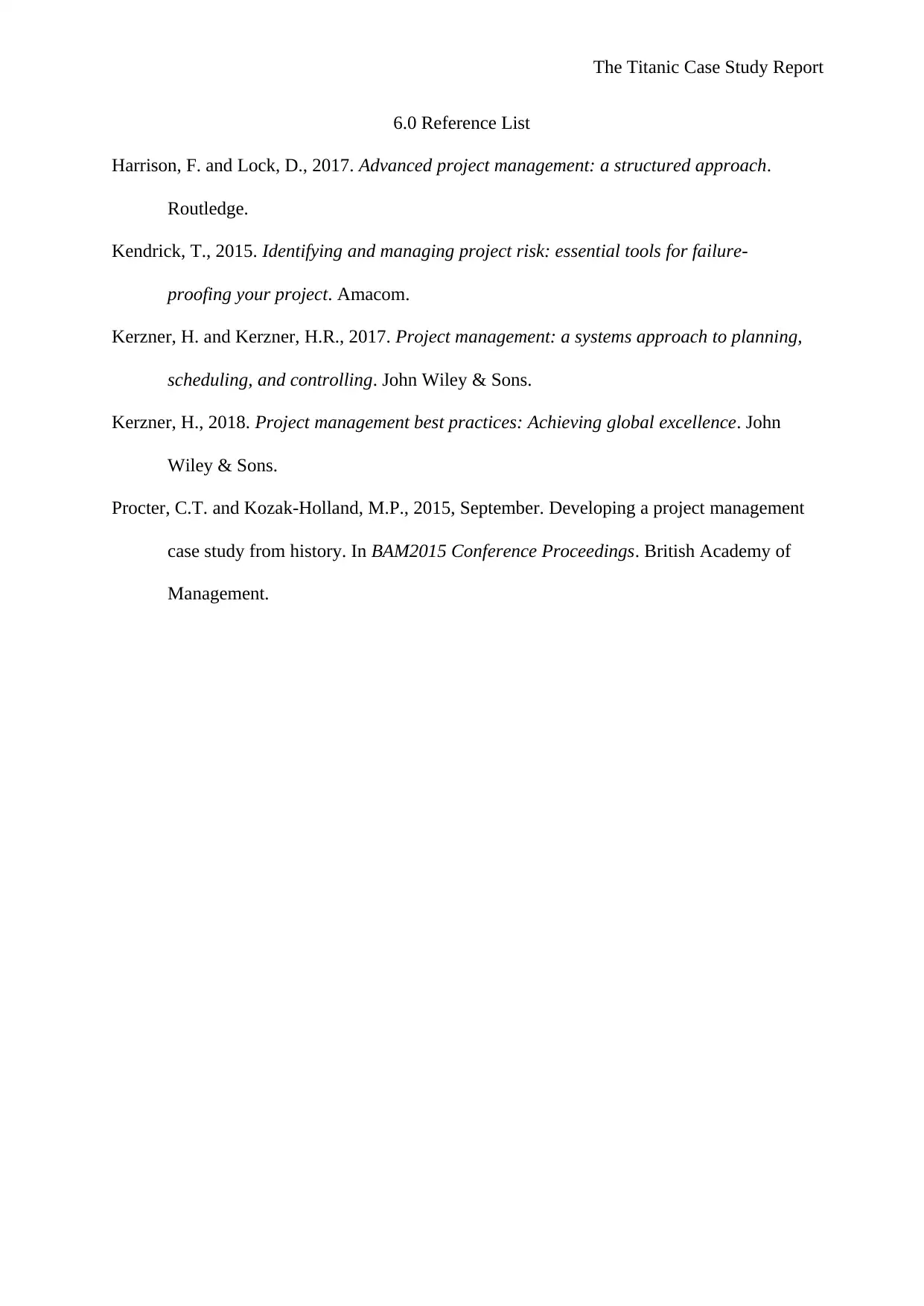
The Titanic Case Study Report
6.0 Reference List
Harrison, F. and Lock, D., 2017. Advanced project management: a structured approach.
Routledge.
Kendrick, T., 2015. Identifying and managing project risk: essential tools for failure-
proofing your project. Amacom.
Kerzner, H. and Kerzner, H.R., 2017. Project management: a systems approach to planning,
scheduling, and controlling. John Wiley & Sons.
Kerzner, H., 2018. Project management best practices: Achieving global excellence. John
Wiley & Sons.
Procter, C.T. and Kozak-Holland, M.P., 2015, September. Developing a project management
case study from history. In BAM2015 Conference Proceedings. British Academy of
Management.
6.0 Reference List
Harrison, F. and Lock, D., 2017. Advanced project management: a structured approach.
Routledge.
Kendrick, T., 2015. Identifying and managing project risk: essential tools for failure-
proofing your project. Amacom.
Kerzner, H. and Kerzner, H.R., 2017. Project management: a systems approach to planning,
scheduling, and controlling. John Wiley & Sons.
Kerzner, H., 2018. Project management best practices: Achieving global excellence. John
Wiley & Sons.
Procter, C.T. and Kozak-Holland, M.P., 2015, September. Developing a project management
case study from history. In BAM2015 Conference Proceedings. British Academy of
Management.
1 out of 7
Your All-in-One AI-Powered Toolkit for Academic Success.
+13062052269
info@desklib.com
Available 24*7 on WhatsApp / Email
![[object Object]](/_next/static/media/star-bottom.7253800d.svg)
Unlock your academic potential
Copyright © 2020–2025 A2Z Services. All Rights Reserved. Developed and managed by ZUCOL.